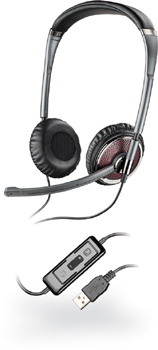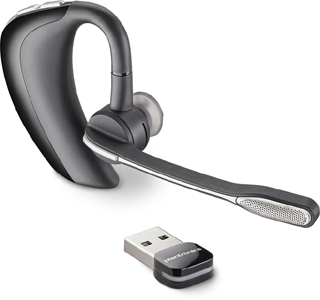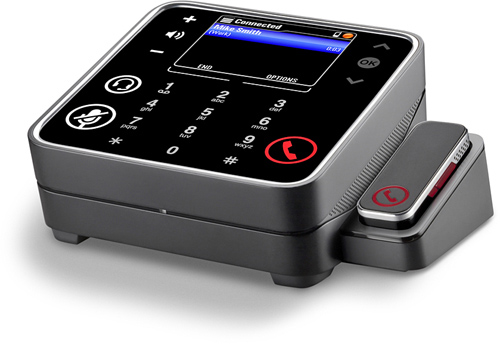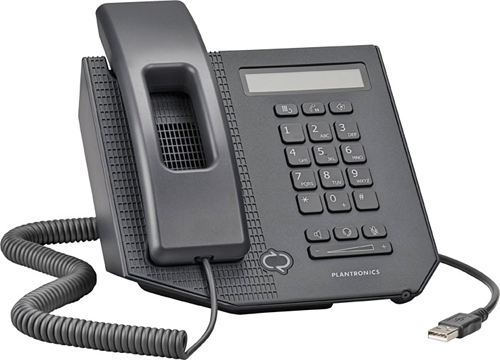Headsets
Headsets are portable and they provide a superior experience to a
traditional handset in nearly every way. However, they take a little
bit of getting used to. There is a wide variety of headsets available
from several manufacturers. In fact, there are too many individual
headset models to discuss all of them here, so we highlight a handful
of devices—at least one from each category: wired and wireless.
A good example of a USB-wired headset is the Plantronics Blackwire 420 (see Figure 1).
This is an affordable solution for desktop users or even mobile users
because it folds flat to be stored in a laptop bag. It provides
binaural audio with an adjustable boom microphone.
Figure 1 Plantronics Blackwire 420

Other solutions include monaural audio, which might be better for
some environments where workers still need to hear the environment
around them.
Wireless headsets have a dongle plugged into
the user’s PC but require no other connections. The headset enables the
user to roam freely up to 300 feet from the PC. Many headsets also have
controls for redial, answer, hang up, and volume control. An great
example is the Plantronics Voyager Pro UC shown in Figure 2.
Figure 2 Plantronics Voyager Pro UC

Tip
Most wireless solutions have docking stations
used for recharging, whereas others come with just a USB charging
cable. The latter are better for users who travel often or might not
have a permanent office.
Speakerphones
Although there is only a niche market for USB speakerphones, they
still play an important role in the UC endpoint ecosystem. These
devices are designed for impromptu meetings or group conversations in
locations without a dedicated conferencing device. The Plantronics
Calisto 825 in particular has a remote microphone, as shown in Figure 3.
The remote microphone makes this speakerphone perfect for leading
meetings in an auditorium or across the room from the device.
Figure 3 Plantronics Calisto 825

USB Handsets
Sometimes there’s no need for a deskphone, but a user insists on
having a handset form factor. These devices connect to a user’s PC
through a USB but provide the familiar user interface and look and feel
of a traditional phone handset. From the PC’s perspective, the handset
is just another audio device for Lync Communicator. However, for the
user, the handset is a familiar tool that works the same way as the
legacy phone. This can be a great tool to begin the process of
empowering nontechnical users with UC. The Plantronics Calisto 540
shown in Figure 4 shows off a caller ID screen and powerful speakerphone.
Figure 4 Plantronics Calisto 540

Webcams
It’s difficult to say that anything is more revolutionary than
desktop video. Even better is high-definition desktop video. Add in
integration with popular video conferencing solutions from Tandberg and
Polycom and you have a complete solution. Adding video to a
conversation has a profound impact. Although most newer laptops are
equipped with webcams, USB-connected webcams are ideal for users with
desktop systems or external monitors.
Users with a webcam can share video with one or multiple
users at the same time. The receiving user will see a request bar
asking to share video for the current conversation. The Microsoft RT
Video codec constantly adapts to network conditions, providing the best
quality for the conditions available.
Conferencing Devices
New to Lync Server 2010 are conferencing devices. Well, that’s not
entirely true... Microsoft released the Roundtable device with five
cameras for a conference room. It didn’t sell well and was licensed to
Polycom as the CX5000. It was expensive and simply too much and too
complicated for most scenarios. It also required connecting to a PC.
The new Polycom CX3000 conference phone is a true conference room
solution. It offers a 3.5-inch QVGA screen with all the Lync
integration functions users expect. Most importantly, it’s a standalone
device. It just needs power (AC or PoE) and an Ethernet cable—no PC
required! It also allows for Outlook contacts search and
one-click-to-join Lync conference calls.
Note
Lync Server also offers tight integration with the Polycom HDX room video conferencing platform when video is a requirement.